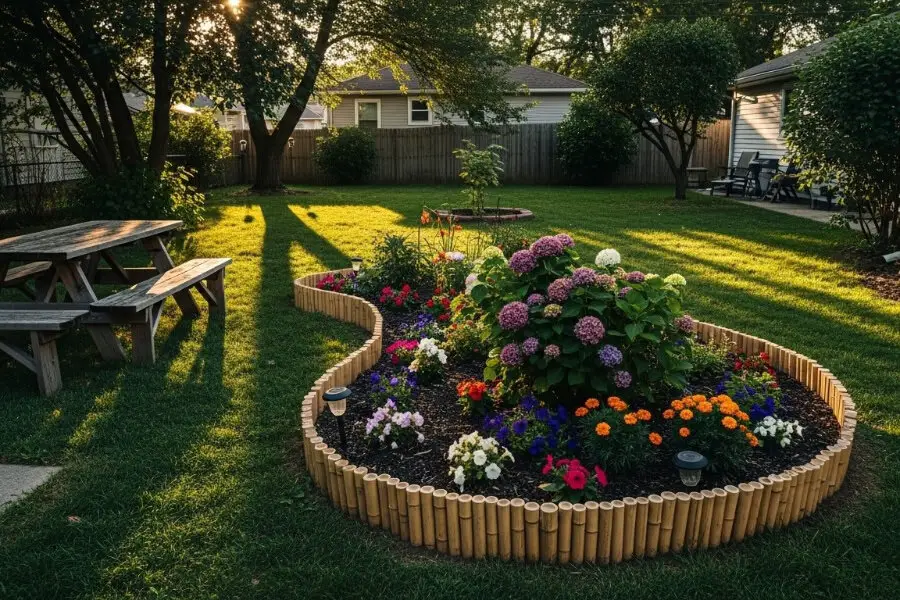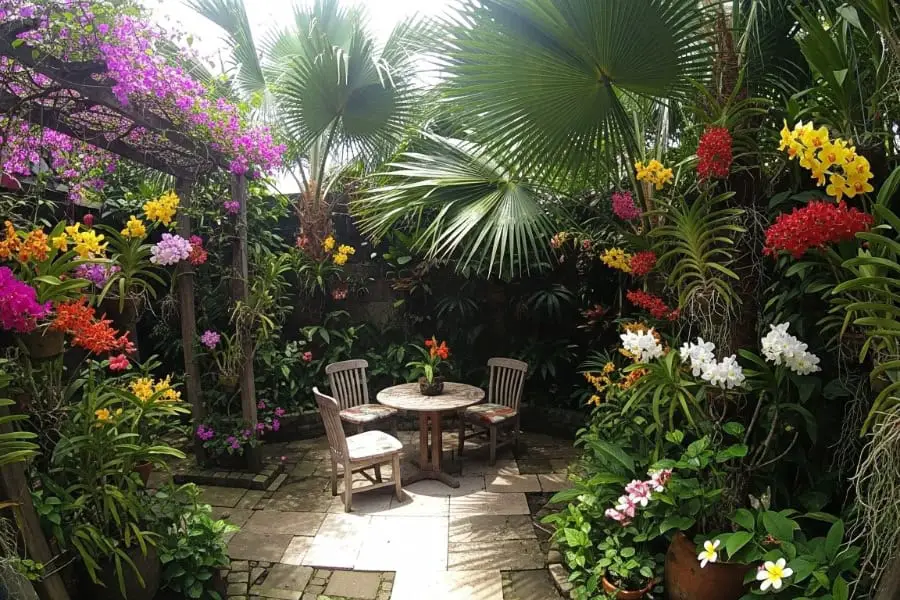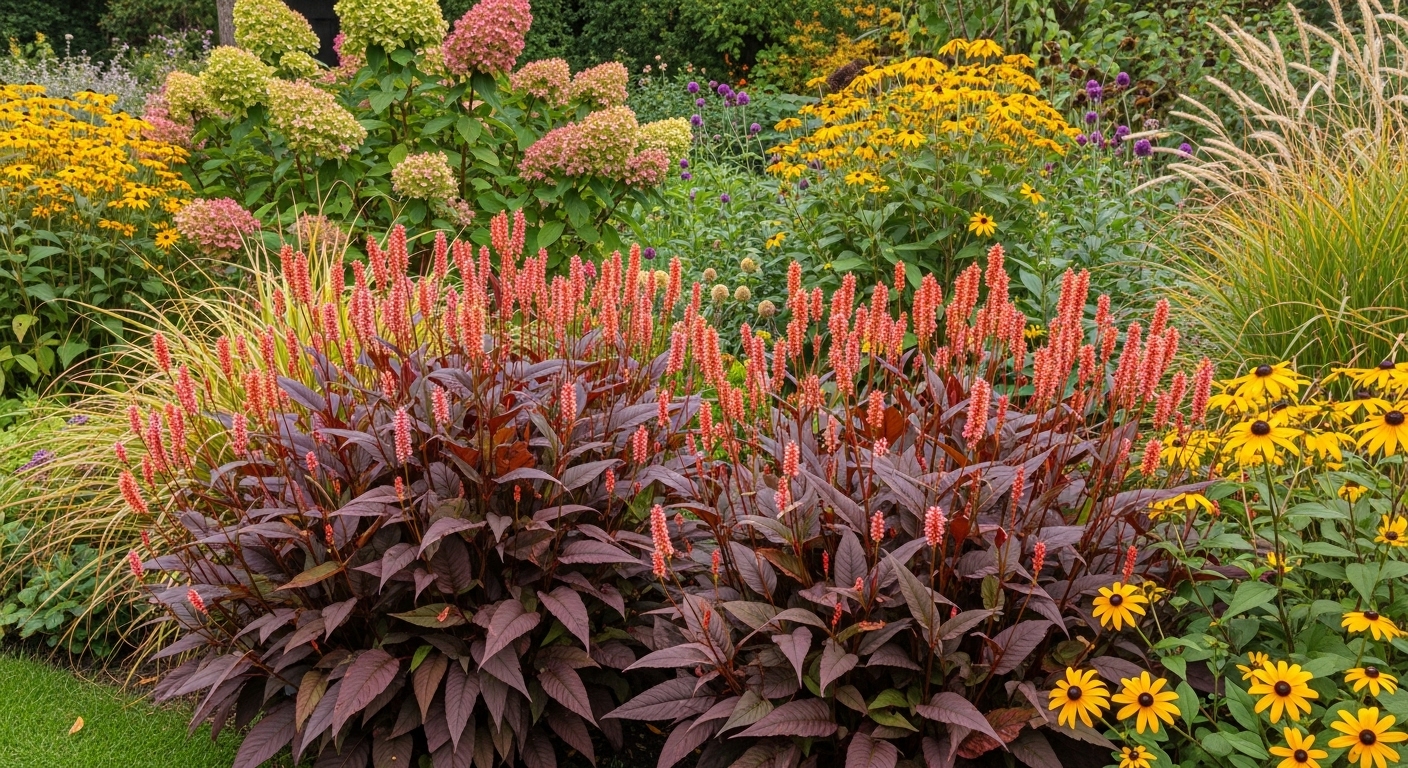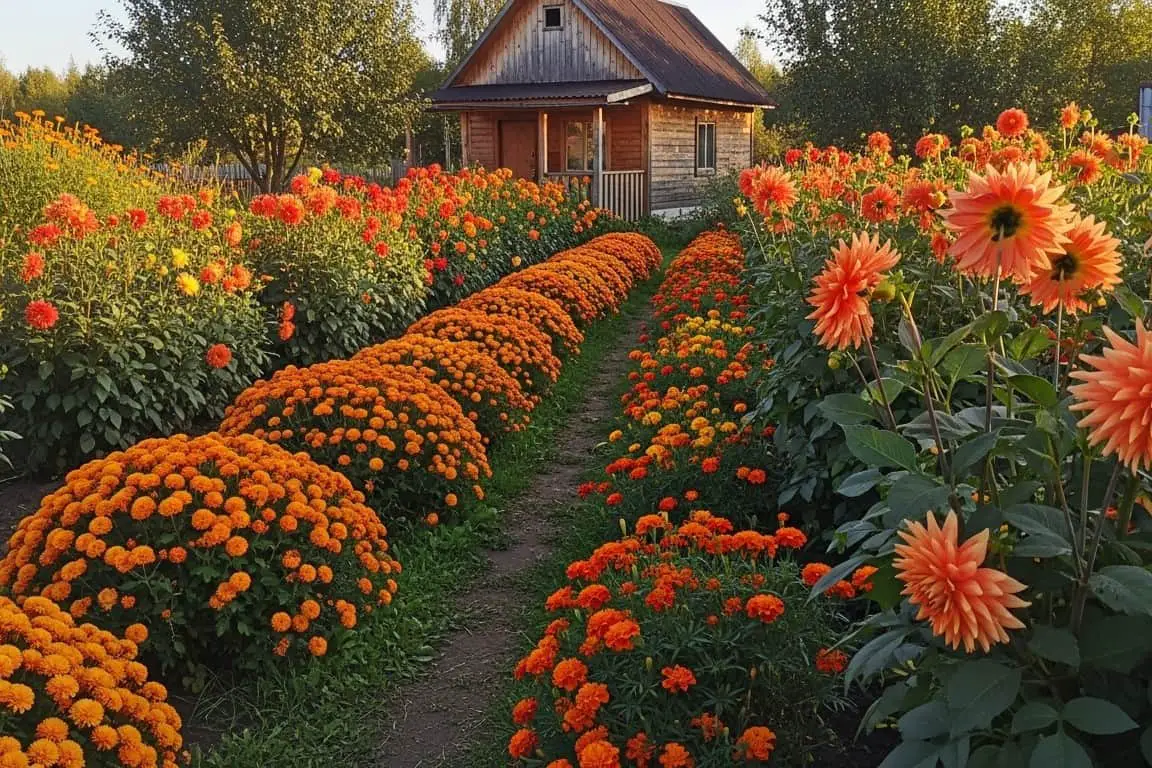
Garden Lovers!
Having trouble getting your garden to thrive? It can be tough finding ways to create a lively, natural space.
Wildflower gardens are a simple way to add beauty while also helping the environment. Here are 25 wildflower garden ideas to inspire you and bring your yard to life!
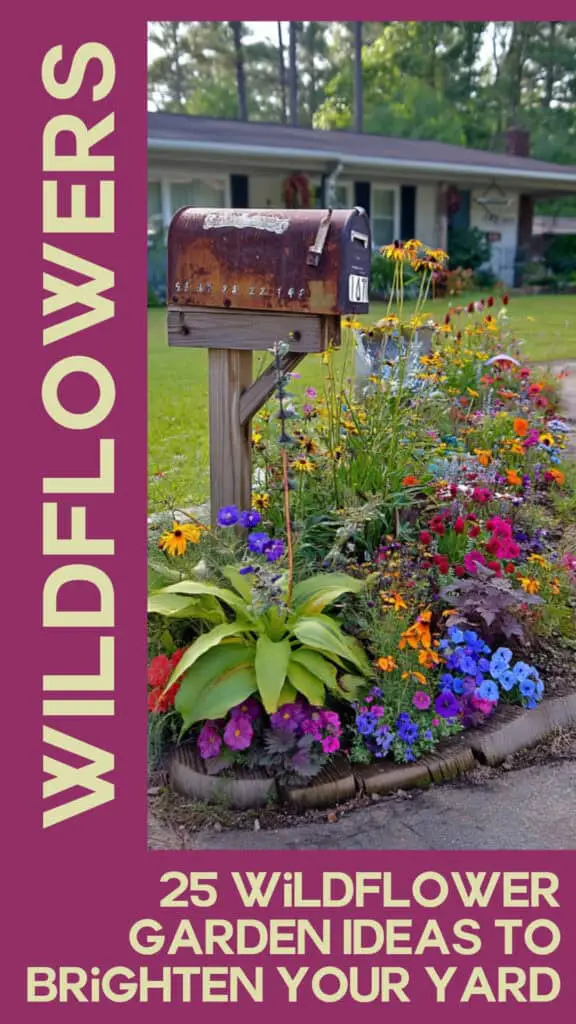
Contents
- 1 25 Wildflower Garden Ideas
- 1.1 Balcony Pots
- 1.2 Corner
- 1.3 Cottage
- 1.4 Desert
- 1.5 Front Yard
- 1.6 Hillside
- 1.7 Lawn Island
- 1.8 Modern
- 1.9 Tree Ring
- 1.10 Arch
- 1.11 Border
- 1.12 Box
- 1.13 Container
- 1.14 Along Fence
- 1.15 Gate
- 1.16 In Pots
- 1.17 With Path
- 1.18 Grass
- 1.19 Mailbox
- 1.20 Meadow
- 1.21 Pondside
- 1.22 Raise Beds
- 1.23 Roof
- 1.24 Vertical
- 1.25 Filled Rock
- 2 Conclusion
- 3 FAQs
25 Wildflower Garden Ideas
Wildflowers can transform any space into a lively, colorful haven. From cozy corners to creative pots, there’s so much you can do!
Balcony Pots
I love growing wildflowers in pots on my balcony. They bring so much color and life to small spaces. I use large pots at least 12 inches deep with good drainage holes to avoid soggy roots.
A mix of garden soil and compost keeps the plants healthy.
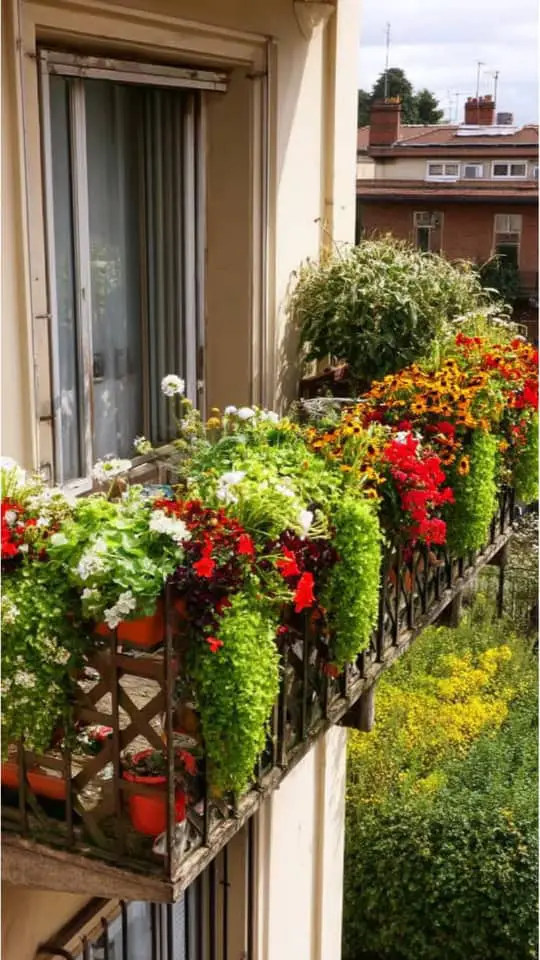
Native wildflowers are my favorite since they adapt well and attract pollinators like butterflies. Black-eyed Susans and cornflowers come back every year, while cosmos or poppies add quick seasonal blooms.
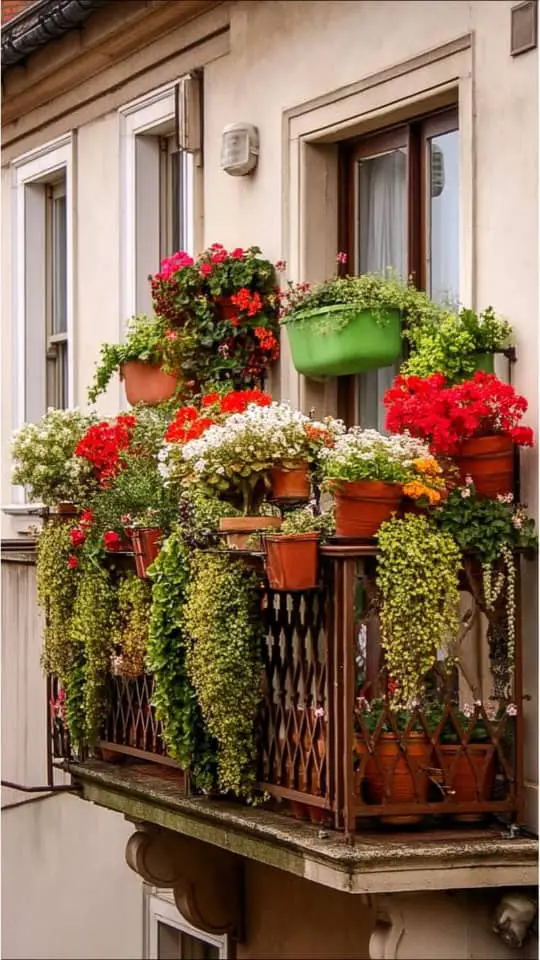
Light watering works best; too much water can make them weak and leggy in full sun areas.
Corner
Rocks add charm and structure to a wildflower corner. Daisies brighten the space with cheerful blooms. I like using native plants that attract pollinators, like bees and butterflies.
Hardy perennials work great here since they need less care over time.
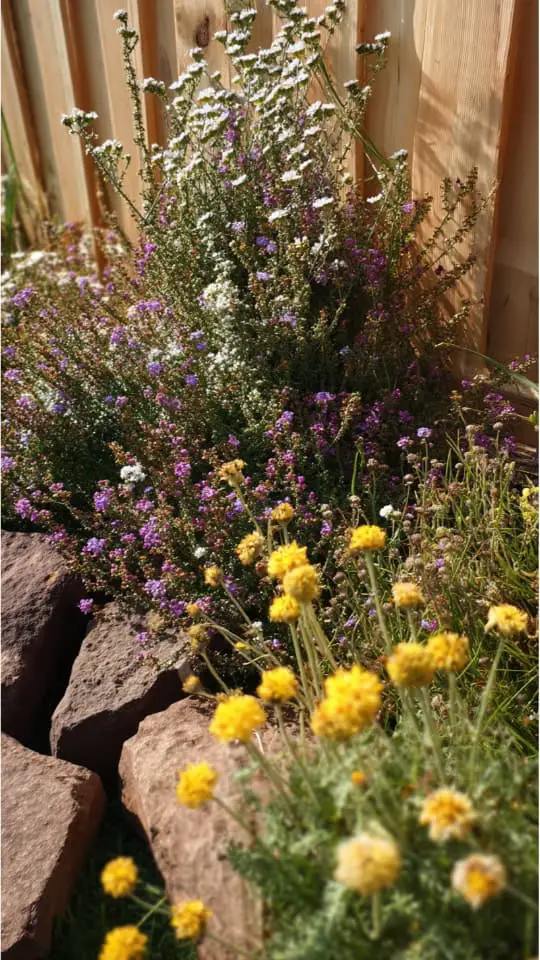
To prepare a rocky spot, I remove weeds and add composted soil for better growth. A mix of annuals and perennial wildflowers keeps colors fresh each season.
Daisies thrive in both full sun and partial shade, making them perfect for tricky corners or shaded edges!
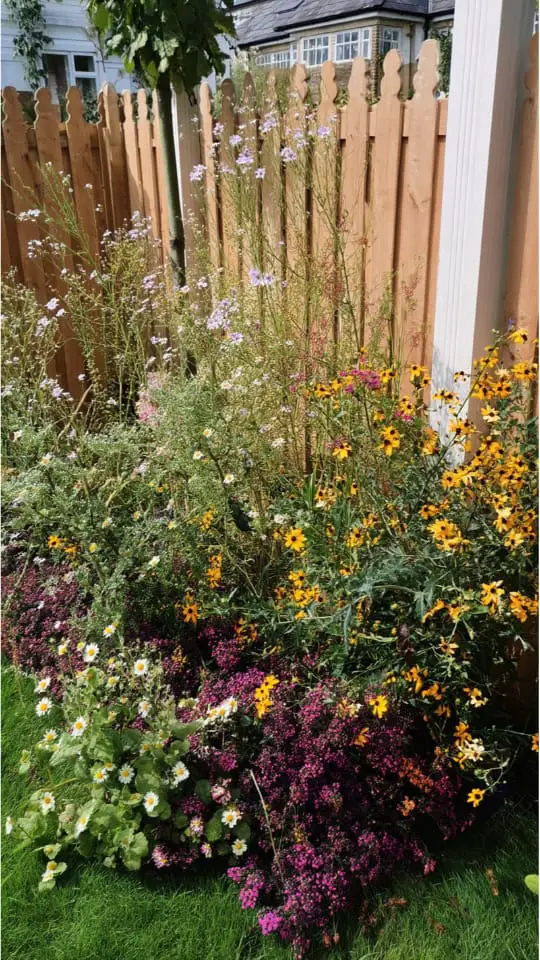
Cottage
Bright wildflowers like hollyhocks and cosmos create a dreamy border along stone steps. I love adding yarrow too, since it blends well with the warm cottage look.
These flowers need full sun and thrive in compost-enriched soil. Mixing perennials with annuals ensures color all season.
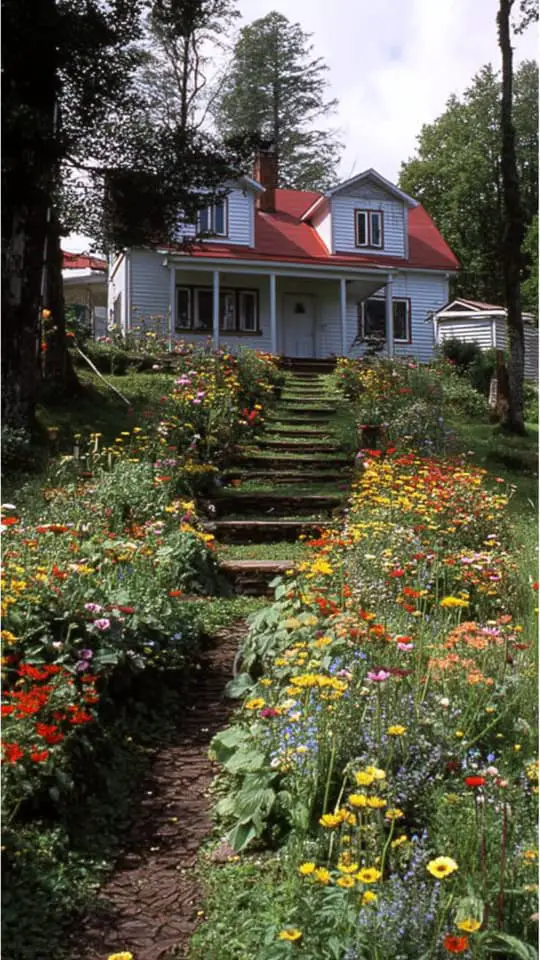
A simple mosaic pathway pairs perfectly with rustic fences or arbors in this kind of garden. Pollinators like butterflies and hummingbirds often visit, making it lively!
Adding pink, yellow, and purple blooms keeps the colors balanced and inviting. Next is how desert wildflower gardens bring beauty to dry spaces.
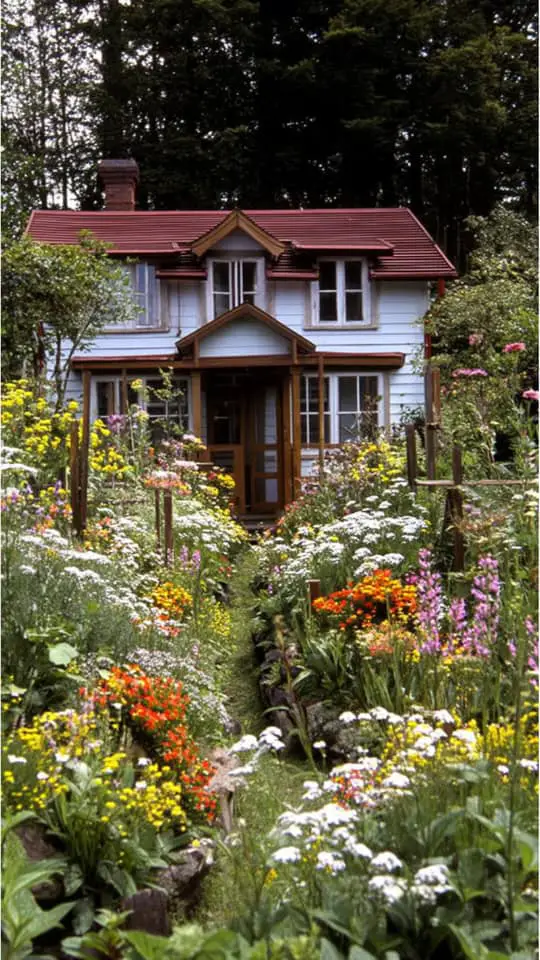
Desert
Golden desert gold and poppies burst against tall cacti. Their yellow blooms shine brightest in March and April.
I love how the vibrant flowers mix with red-orange, purple, and whitish-pink hues.
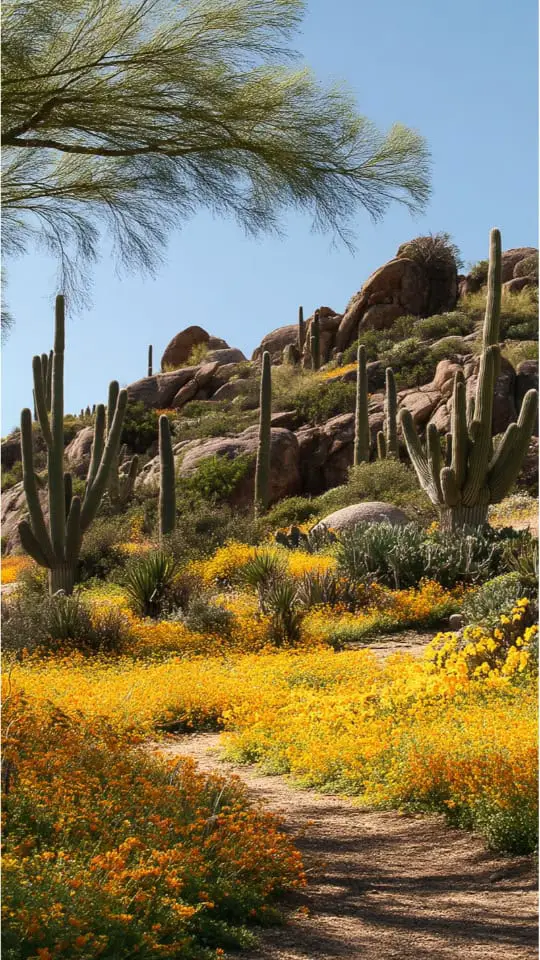
Adding rocks helps drainage in dry soil. Succulents like agave or aloe fit perfectly too. These gardens show wildflowers’ strength even in harsh deserts.
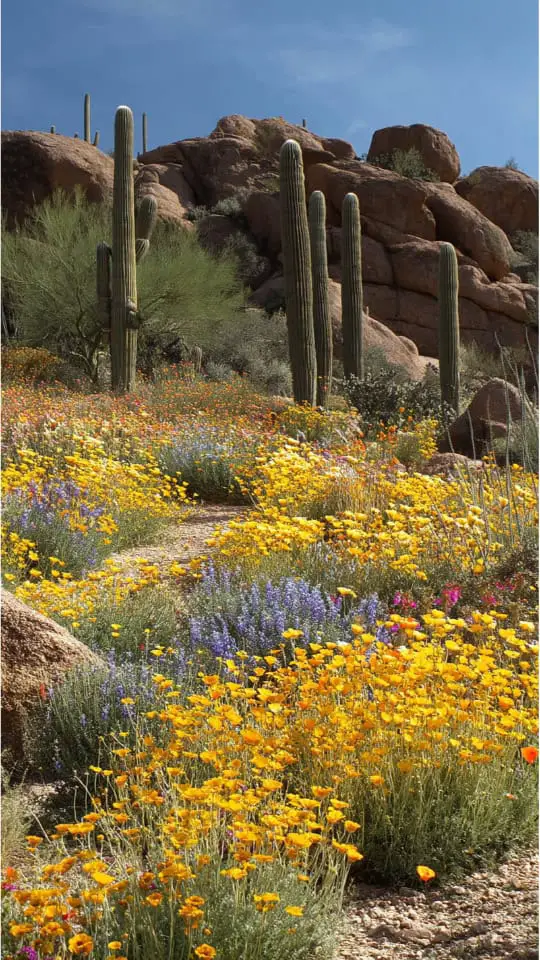
Front Yard
I love using wildflowers to turn a plain front yard into something special. A pathway lined with forget-me-nots, echinacea, and columbines feels warm and natural.
These native plants are low-maintenance and thrive in partial sun or even shade. Adding seasonal bulbs like tulips or daffodils brings early spring color before the wildflowers bloom.
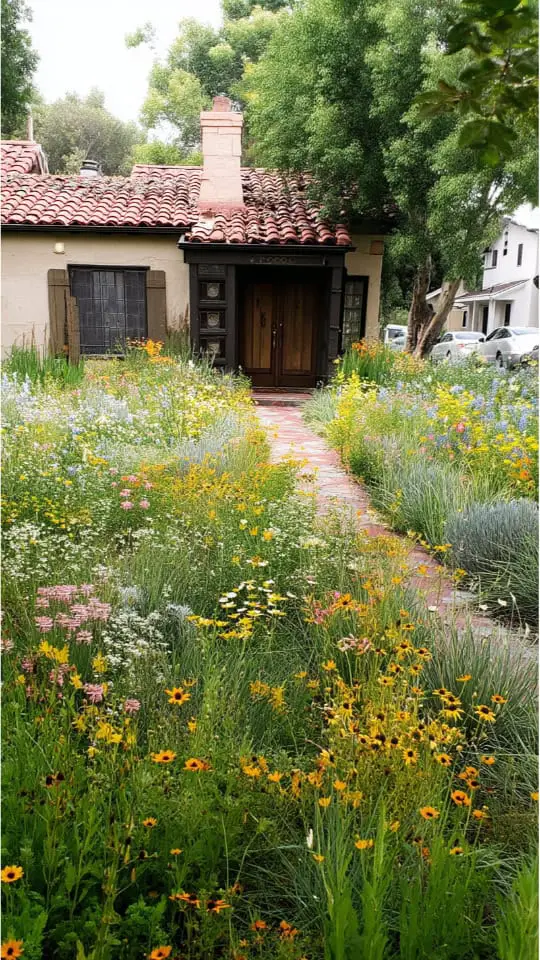
This garden doesn’t need much work after planting. Mulching cuts down on weeding, while hardy fescues can fill gaps between flowers.
It also helps pollinators like syrphid flies and butterflies find a safe space close to home. A bright mix of annuals and perennials ensures blooms all year long!

Hillside
A hillside is perfect for a wildflower garden. The vibrant blooms in summer make the slope look alive. I like to plant native wildflowers here because they hold the soil and stop erosion.
Bright flowers like zinnias and sweet alyssum attract bees and butterflies too.
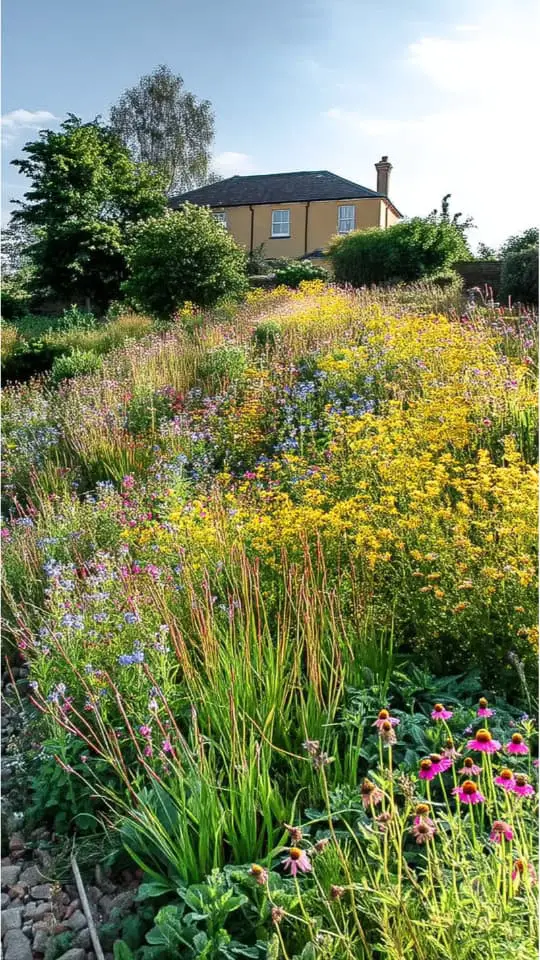
I prepare slopes by pulling tough grass, then adding compost or organic matter for healthy growth.
Perennial wildflowers such as achillea millefolium work well on hillsides with less watering needed due to runoff. Planting sweet william also adds bold color that stands out across the meadow!

Lawn Island
I love creating a wildflower island in my lawn! I use stones to form a neat circle, keeping the display tidy and beautiful. For seeds, mixes like the Northeast Wildflower Mix work great.
Adding sunflower seeds gives height and variety. Birds stay away if planted deeper.
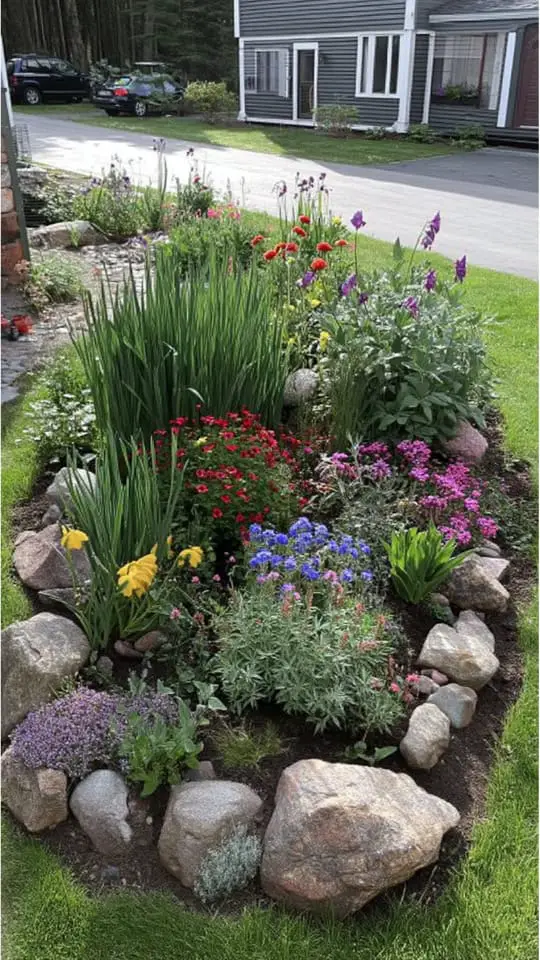
Wildflower islands are perfect for pollinators like bees. They also cut down on mowing time while boosting garden biodiversity.
Every few years, I overseed to keep blooms vibrant. A 3-foot L-shaped bed can start with weed-whacking and tilling first.
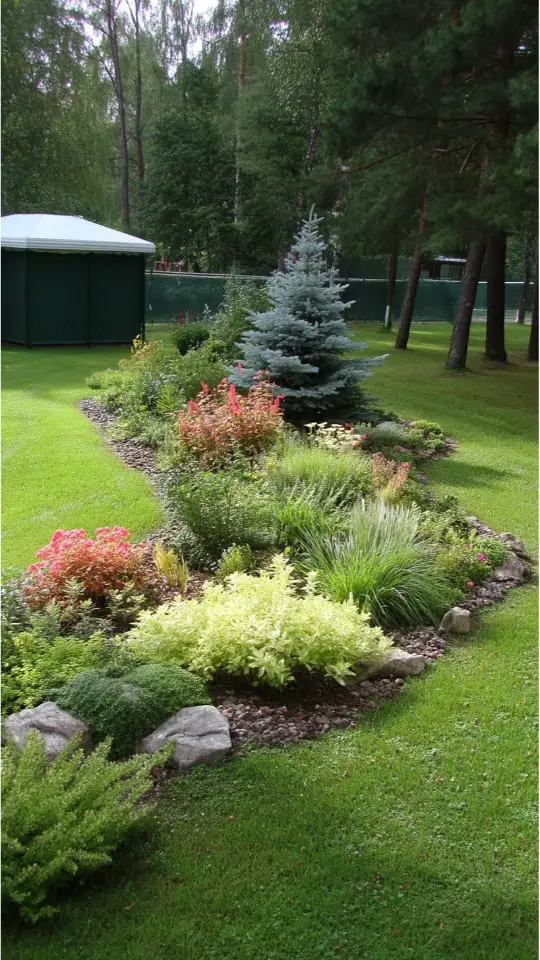
It’s simple but rewarding!
Modern
Clean stepping stones separate bright sections filled with wildflowers. Cornflowers and sweet william bring bold colors to the space.
I prepare the soil by tilling about 3 inches deep and adding compost or fertilizer for healthy growth. Hardy plants, like perennial wildflowers, thrive here with little care needed.
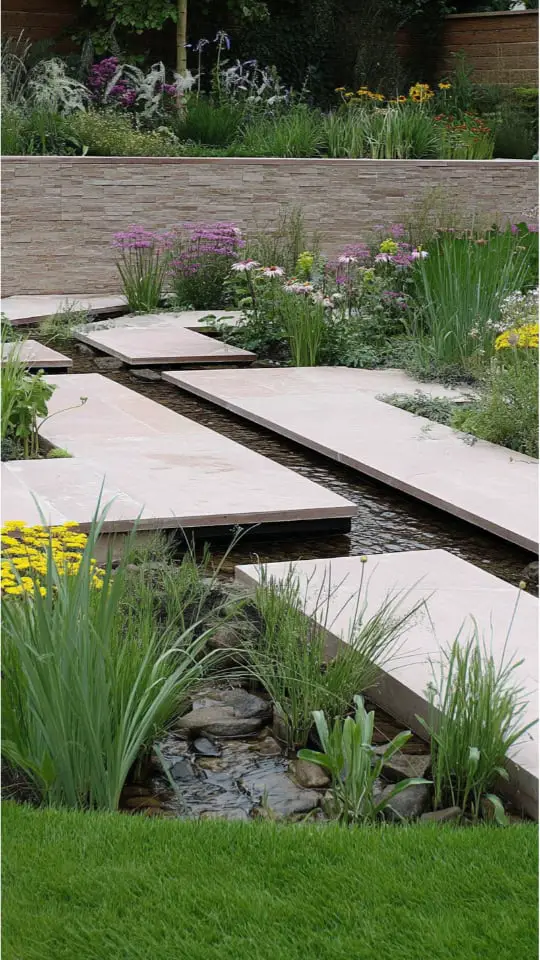
This garden supports pollinators in full sun or partial shade. Adding a natural orchard helps attract more bees and butterflies too.
The mix of structure and blooms creates a fresh, modern look while encouraging biodiversity around my home!
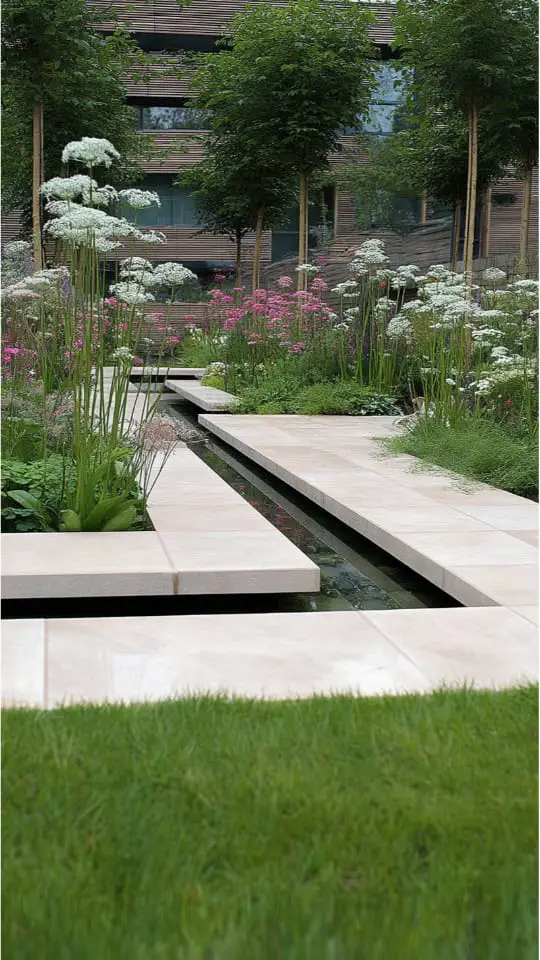
Tree Ring
I love planting wildflower seeds around old tree stumps. It turns unused spots into bright, blooming areas full of life.
Scattering seeds requires little soil prep, making it an easy and fun project. I usually pull out weeds by hand first, then add a bit of compost to help the flowers grow better.
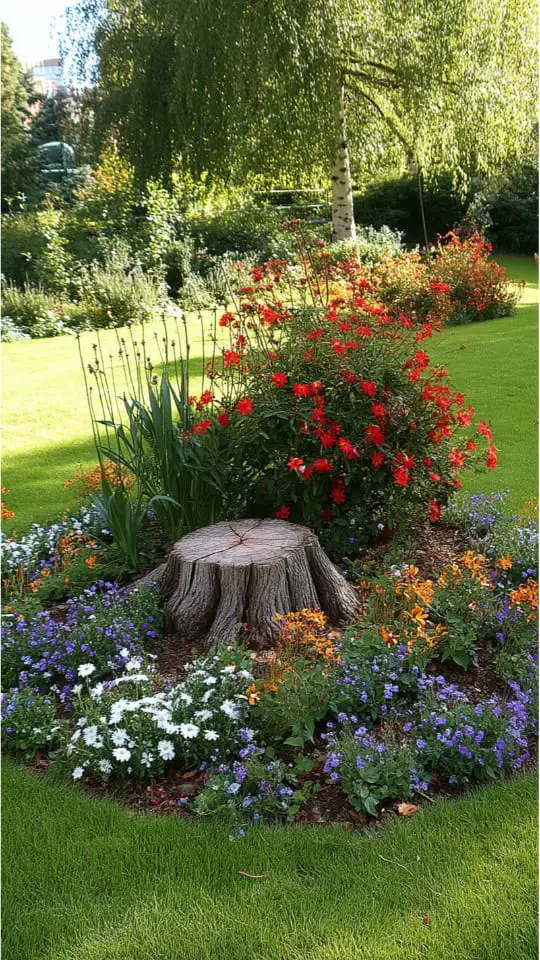
These gardens attract pollinators like bees and butterflies, which keeps my garden buzzing with activity. Perennial wildflowers are a great choice since they return yearly.
Sweet William or common foxglove adds charm too! This setup blends nature’s beauty with purpose while saving space for other ideas in your yard or garden settings nearby!
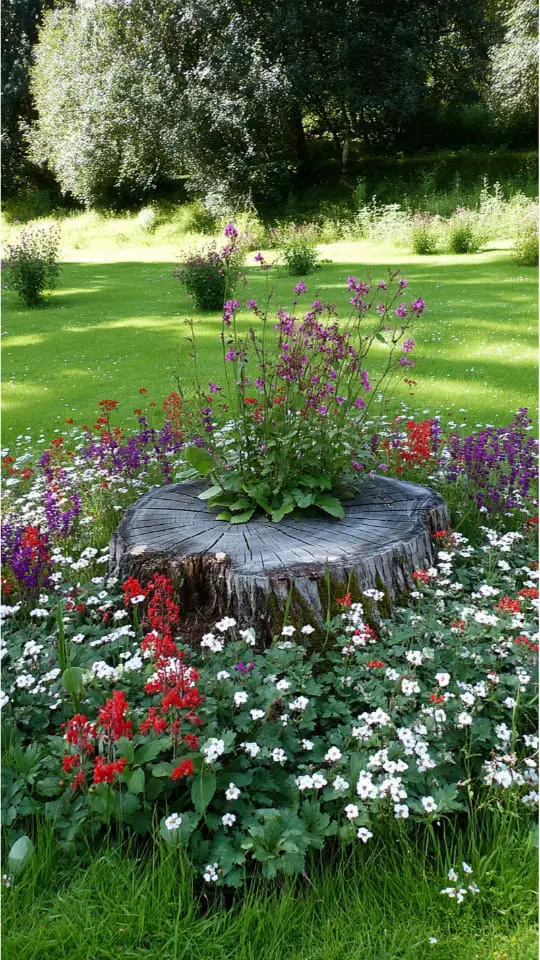
Arch
Twisting vine arches covered in wildflowers create a magical entry. Bright blooms in pink, purple, yellow, and blue climb around the curves.
I find pastel shades like mauve or baby blue add a soft touch to the garden path.
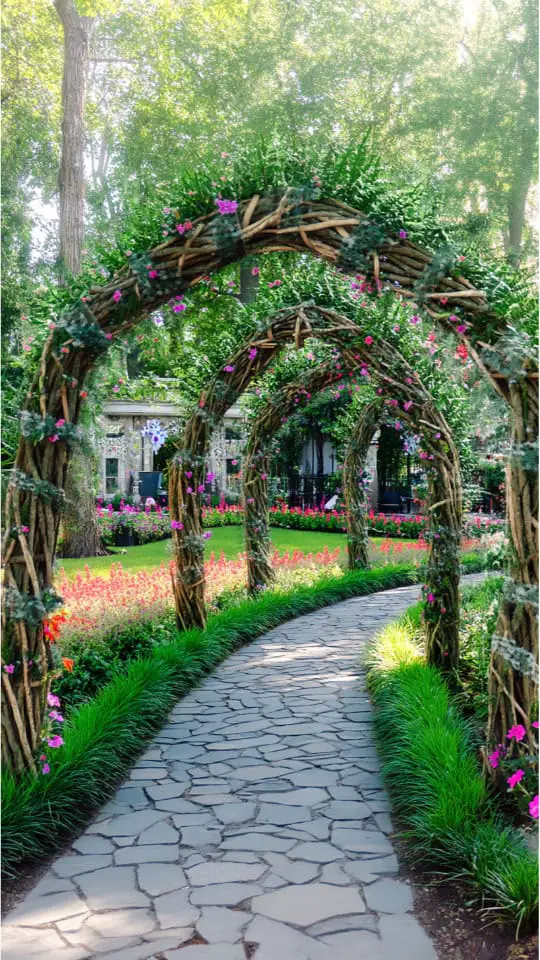
Prices vary for these arch arrangements. Some start at $263.42 and go up to $439.03 based on choices of size or flowers.
Fresh wildflowers look stunning but need care; artificial ones work well for less upkeep.
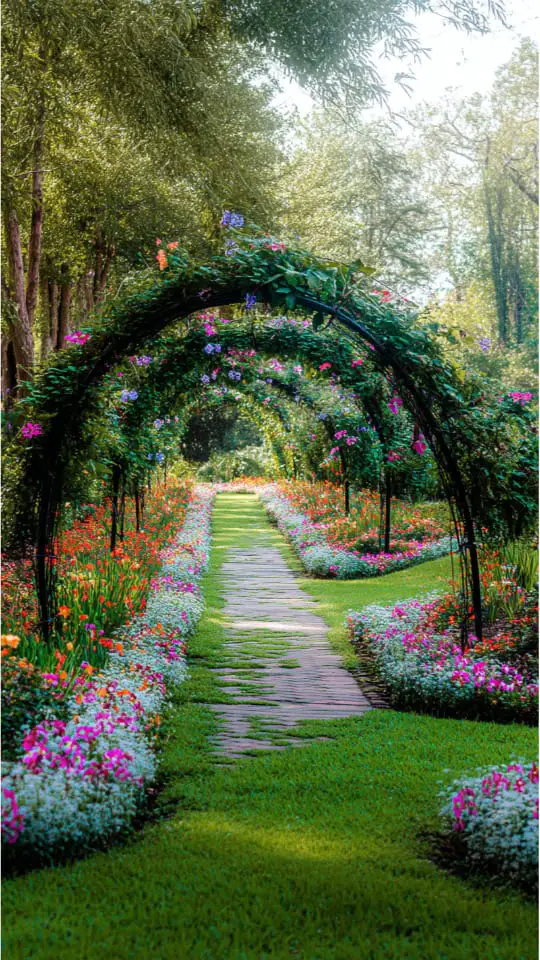
Many sellers even offer free shipping within the U.S., which makes it easy! These arches turn any pathway into a paradise full of natural beauty.
Border
Daisies and cornflowers make a beautiful border along my garden fence. These vibrant flowers thrive in full sun, creating a cheerful edge that attracts butterflies and hummingbirds.

I prepared the soil with topsoil and organic material to support healthy blooms.
These hardy wildflowers are low-maintenance, perfect for defining property lines naturally or deterring pests near vegetable gardens.

Box
A stone border keeps the soil in place and gives the bed a clean look. I rake the soil flat, spread hardy perennial wildflower seeds like lance leaf coreopsis, and water lightly.
Seeds sprout within 10 to 21 days, with blooms showing up around five weeks later.

Bees and butterflies love this type of garden. Adding compost helps wildflowers grow strong during dry spells. A Mockorange shrub can work as a nice focal point too.

This setup works well in full sun or partial sun areas. For more ideas, let’s explore vibrant balcony gardens next!
Container
Rustic planters make wildflower container gardens so charming. I love using black-eyed Susans, cosmos, and poppies.
These flowers bloom beautifully in pots with at least 12 inches of depth. Adding drainage holes keeps the roots healthy too.
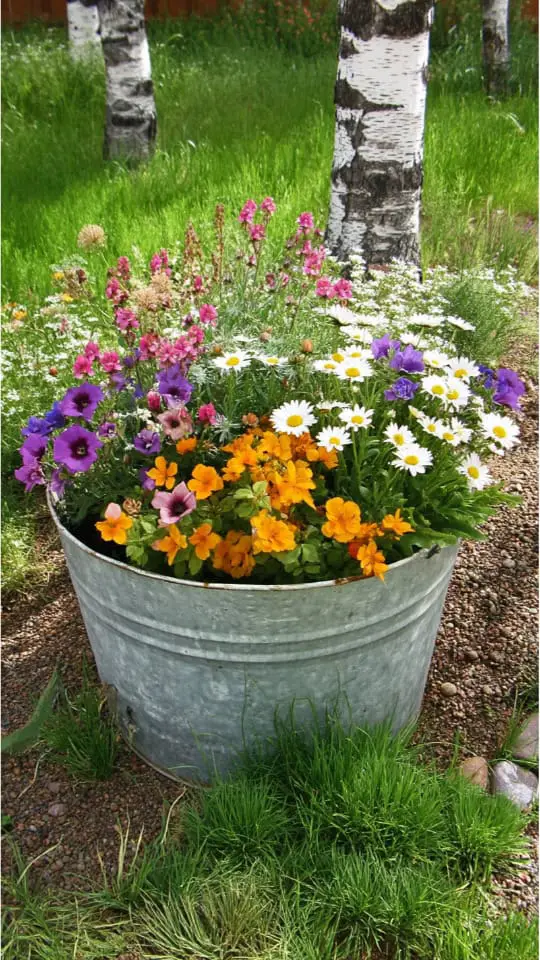
For soil, I mix compost with garden dirt for rich nutrients. My containers sit in full sun for six hours daily. A cheerful mix of colors always brightens my space.
Regular watering checks are key to keeping blooms fresh and lively!
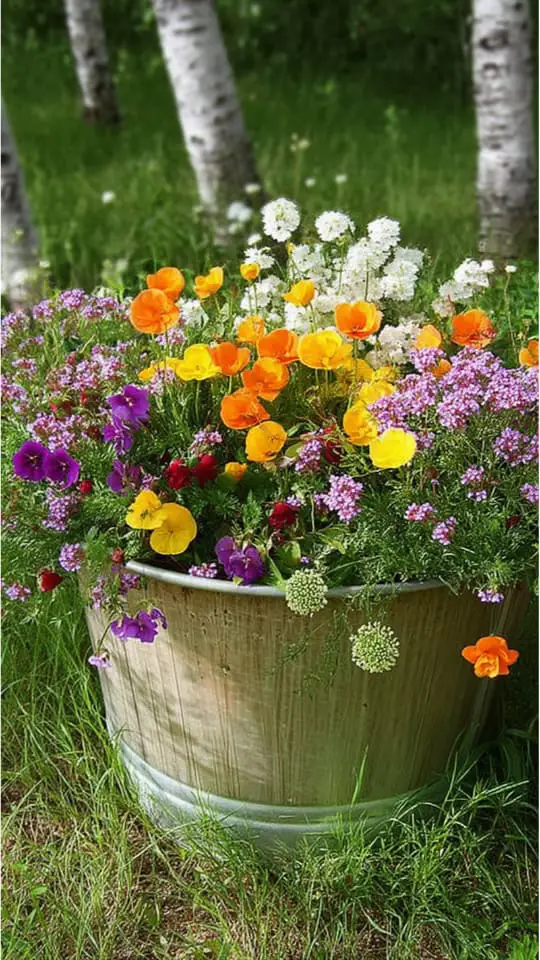
Along Fence
My rustic planter filled with wildflowers inspired me to create a bigger project. I decided to plant vibrant blooms along my fence.
The flowers turned the space into a natural border that felt private and peaceful.
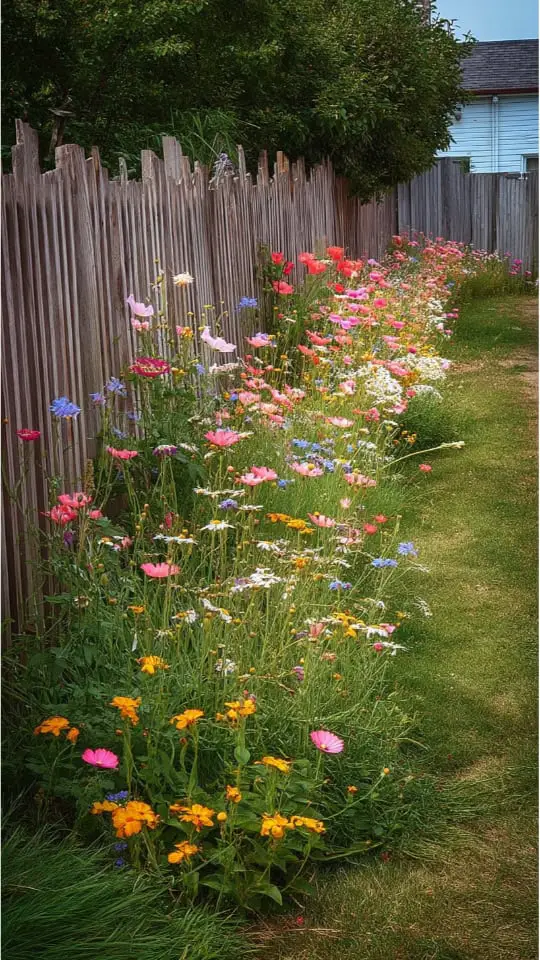
I scattered seeds like yarrow, borage, cosmos, and hollyhocks near my garden hose for easy watering. The Northeast Wildflower Mix worked perfectly for this.
Pollinators flocked to the area in no time! With little watering needed after they grew strong, these hardy plants thrived in partial sun.
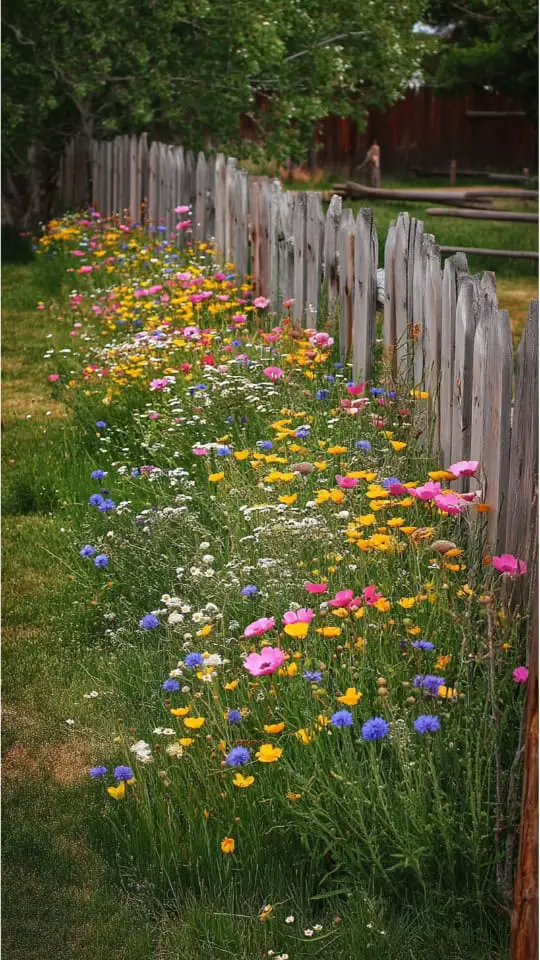
My once plain fence now bursts with color and life every day!
Gate
A wooden gate feels like a doorway to magic when framed by wildflowers. Bright blooms, like shasta daisies and coreopsis, can line the path leading up to it.
I love how they bring color and attract butterflies too!
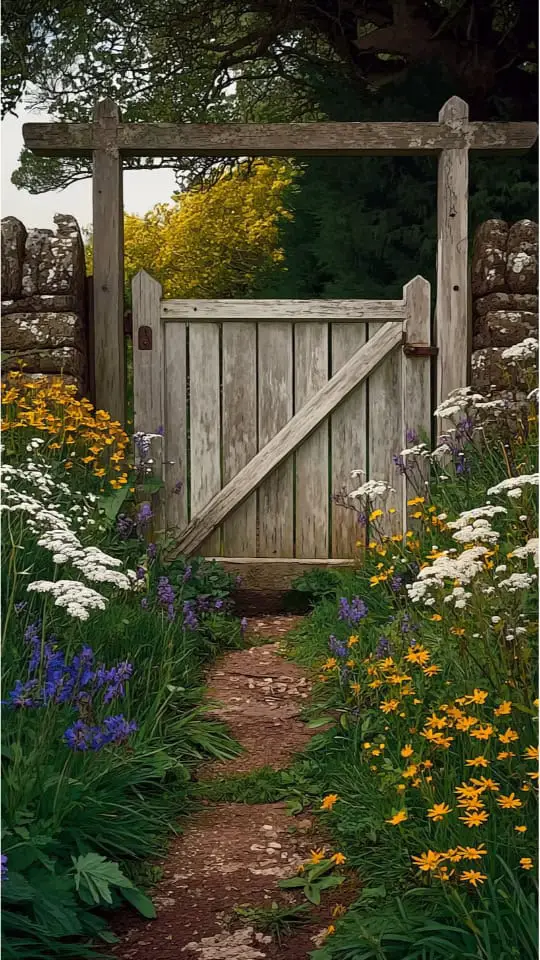
Using stepping stones or mulch for the path makes walking easy. Mixing annual and perennial wildflowers keeps the area blooming all season.
It also creates a natural, inviting look that sets boundaries while boosting curb appeal.
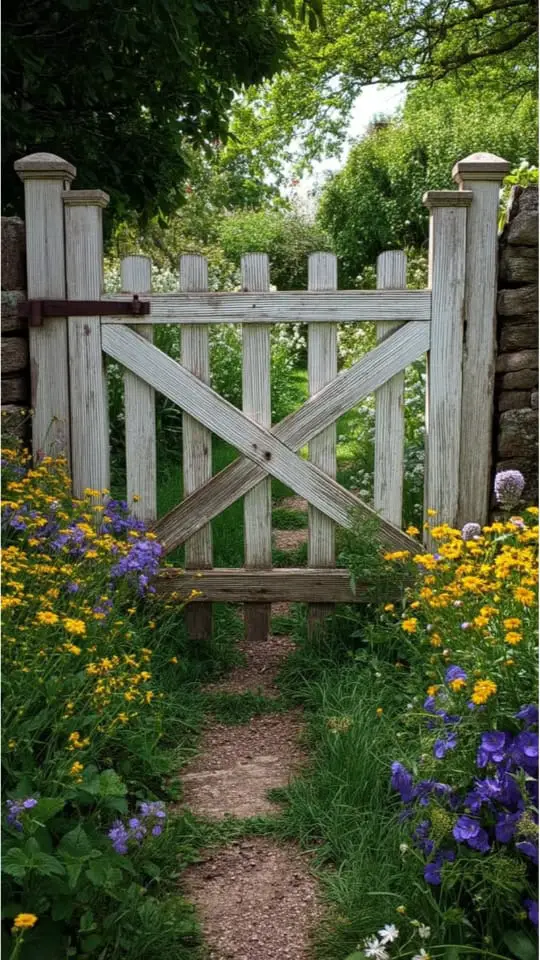
In Pots
I use vintage pots to grow wildflowers in my yard. A mix of annual and perennial wildflowers fills the pots with bold colors.
Compost-rich soil keeps them healthy, while drainage holes stop water from staying too long.

Potted wildflowers are easy to care for and move around. I place them in full sun during the day and shelter them if it rains hard. With a few seeds, I reseed each season so the blooms never end!

With Path
A curving path through wildflowers feels like a secret trail. Gravel or mulch works well for naturalized paths that guide visitors without harming plants.
I enjoy seeing bees and butterflies as they explore the blooms alongside me. Stepping stones make it easy to divide areas by colors, heights, or flower types.

This kind of garden makes small spaces feel bigger. Curves trick the eye into thinking there is more to see around each corner.
I often stop to admire native plants like sweet william, which thrive in full sun and attract pollinators too! Now onto creating cozy spots with pots filled with blooms….
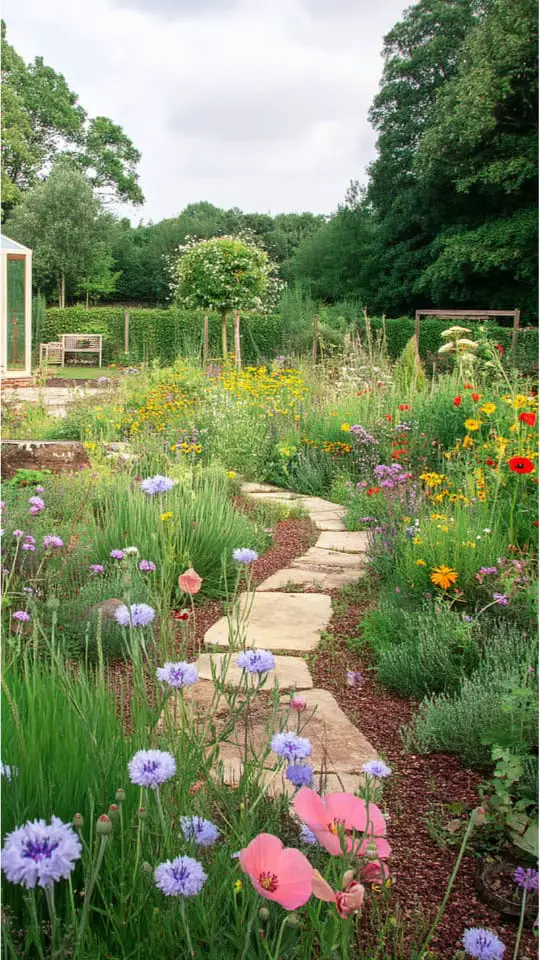
Grass
I love how wildflowers can turn a plain grassy field into a peaceful retreat. My favorite part is watching them sway gently between trees, adding color and life.
These gardens need little care compared to traditional lawns. Wildflowers thrive in poor soil too, which makes planting easy.
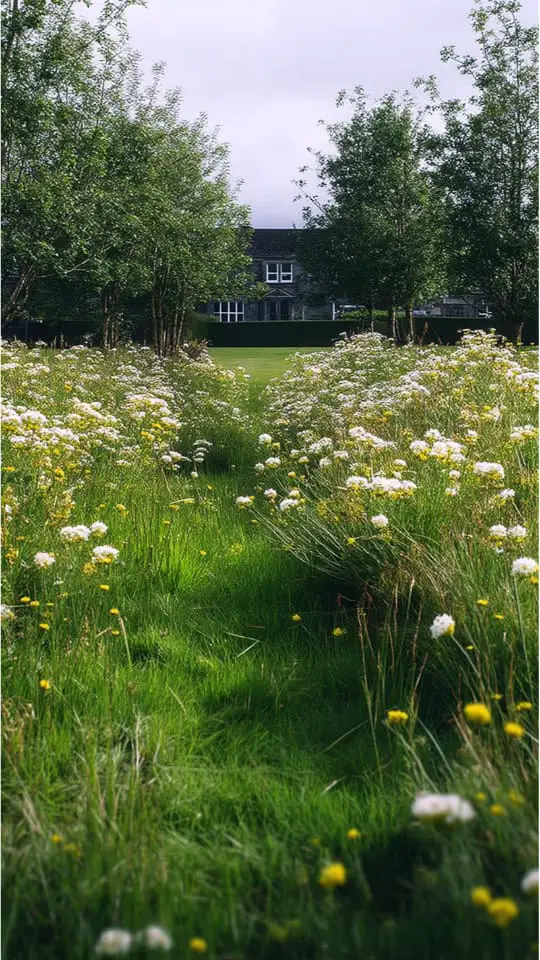
For the best look, I mix native plants with hardy fescues or tall fescue grass seed. Some wildflowers like full sun while others grow better in partial sun or shade.
Watering is important only during germination since they become drought-tolerant later. Pollinators like butterflies often visit these spaces, making it even more special!
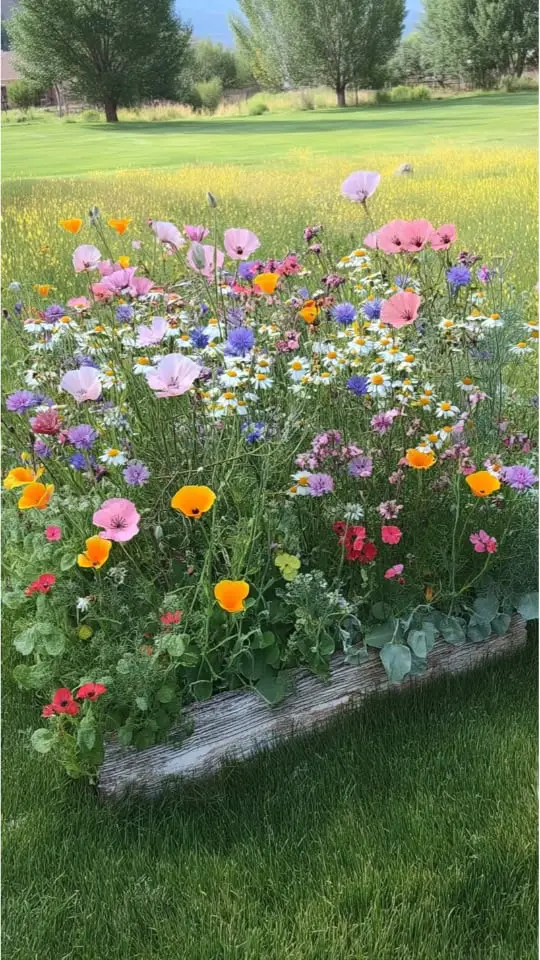
Mailbox
Bright wildflowers around a mailbox make every day cheerful. A mix of native plants and annual wildflowers keeps the blooms lively all season.
I love how bees and butterflies enjoy it too.
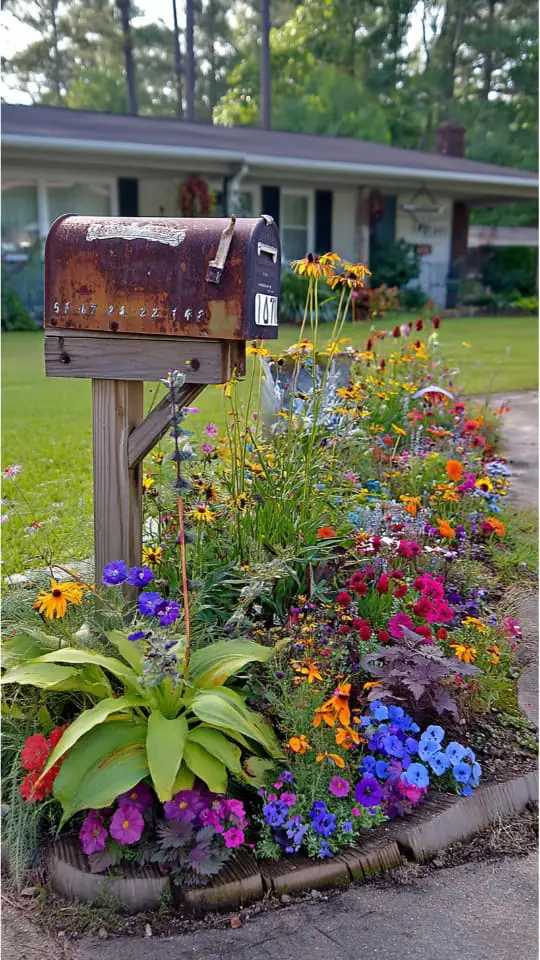
Sweet William, daisies, or even trifolium work well here. Raised beds can help keep things neat or cascading flowers can add natural charm.
Edible plants like herbs bring beauty and utility to this spot. Good sun exposure is key for healthy growth, so I always position mine wisely.
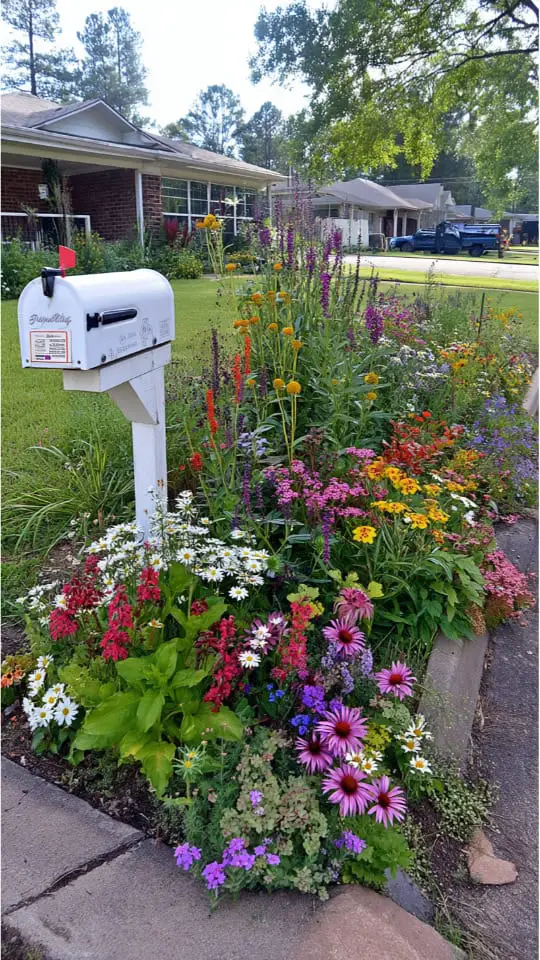
Seasonal touches like pumpkins in fall or fairy lights at Christmas keep it fun year-round!
Meadow
Soft wildflowers in an open meadow feel magical near a rustic mailbox garden. I saw this kind of meadow bloom by mid-September after planting in early July.
It was as easy as scattering seeds and pressing them into the soil. This low-maintenance landscaping worked wonders.

The flowers welcomed bees, butterflies, and even hummingbirds. My friend Jeremiah called his meadow a “pollinator oasis.”
He plans to add four more feet next season using the Northeast Mix. Clouds above make this type of garden feel peaceful yet full of life below!
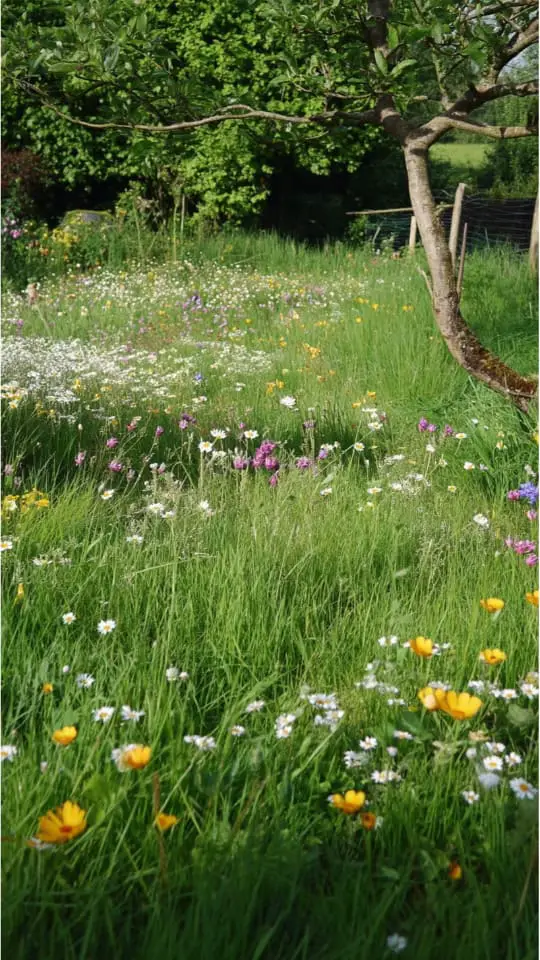
Pondside
I love how a pondside garden feels alive with color and calm. Blooms like yarrow, cosmos, hollyhocks, and Russian sage add soft pastels and warm tones.
Taller perennials in the back create depth while shorter wildflowers fill gaps near the water.
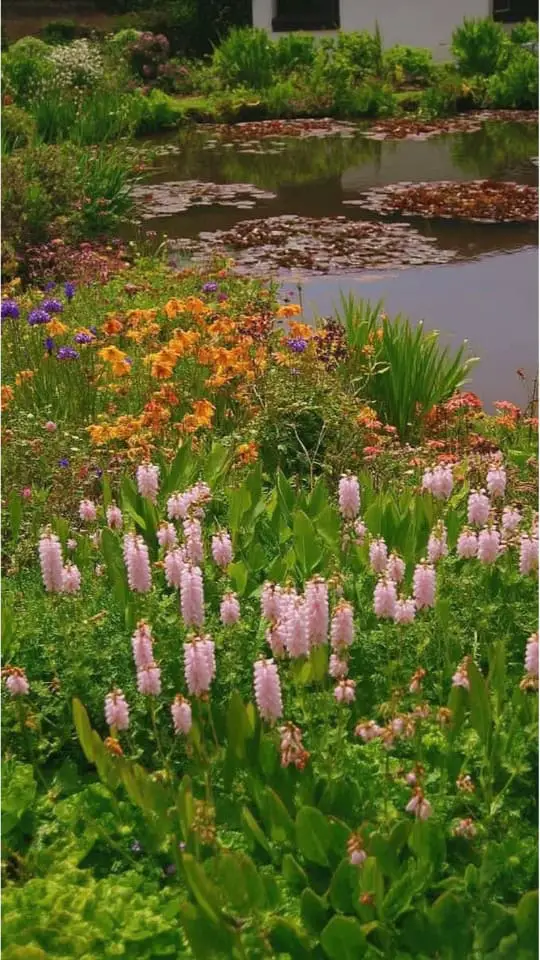
This spot also helps pollinators like bees thrive. The pond’s humidity keeps plants happy too. Adding native wildflowers reduces runoff and protects water quality around the area.
It’s peaceful to see flowers sway by the reflective light coming off the water!
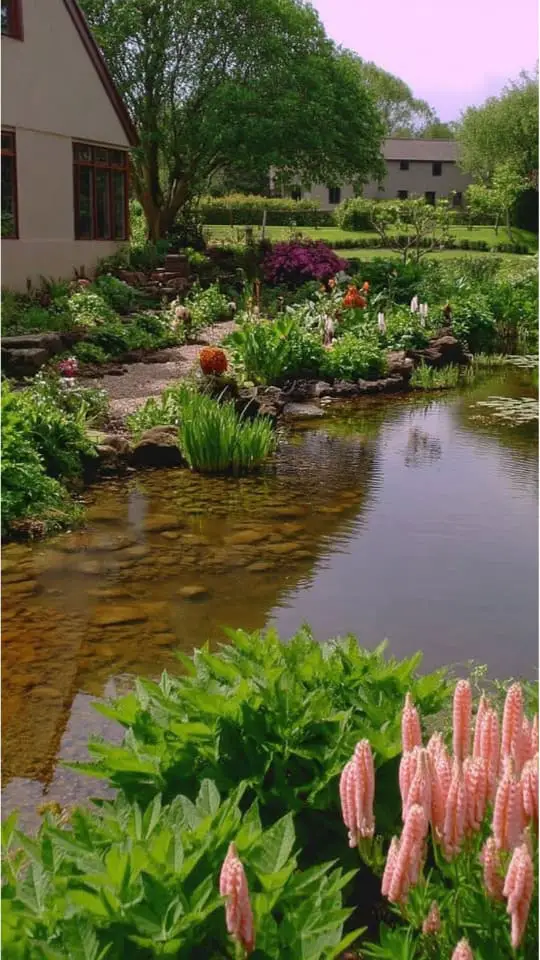
Raise Beds
Bright wildflowers fill raised wooden beds with dense blooms. The controlled soil makes flowers grow well and creates vibrant colors.
I use native plants to attract pollinators like bees and butterflies. These flowers support local ecosystems and add life to my garden.
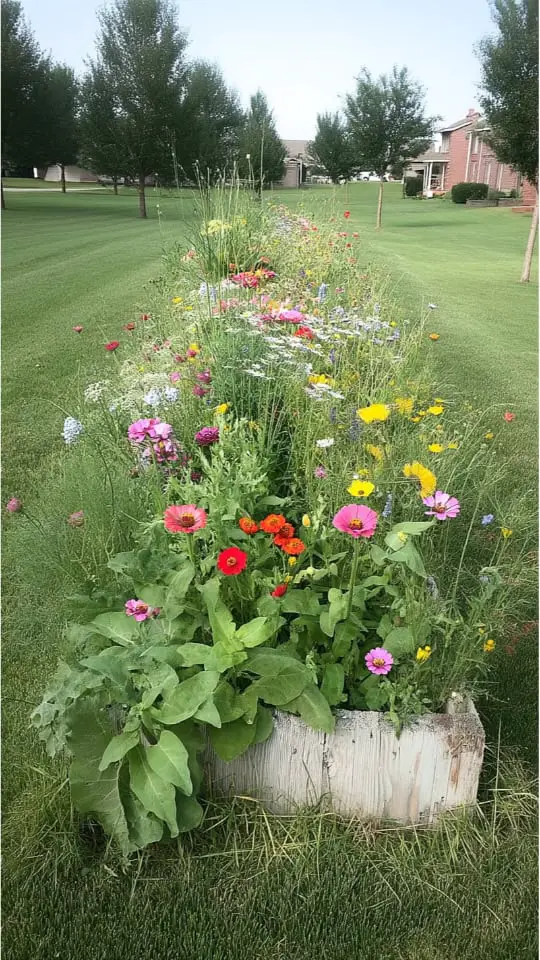
Raised beds make gardening easy. I can weed, water, and care for the plants without bending too much. Using reclaimed wood adds a rustic look that feels warm and natural.
For a functional twist, I mix edible plants with perennial wildflowers here. This setup brings beauty while staying useful in any space!
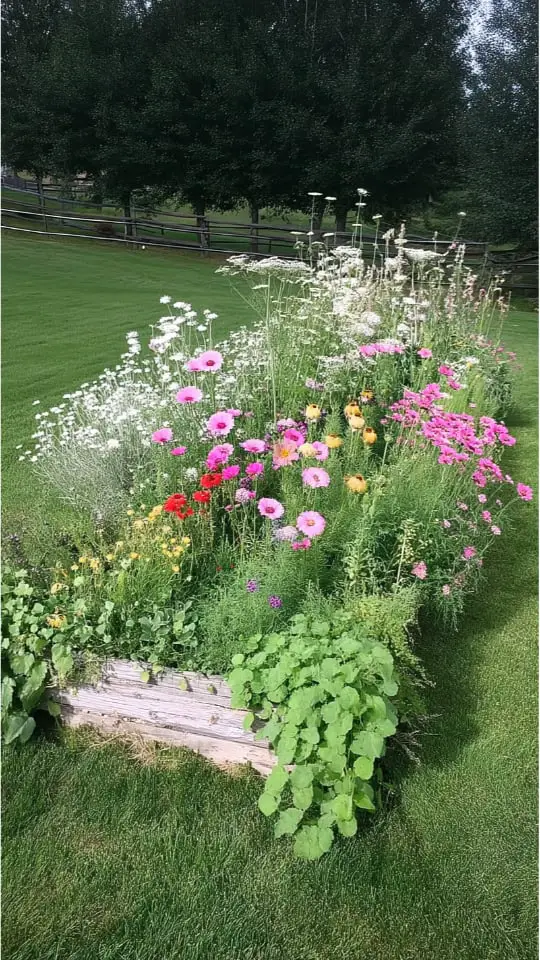
Roof
I like how wildflower roof gardens bring nature to city rooftops. Pink and white blooms create a soft, calming view from above.
These gardens help pollinators like bees and butterflies thrive in busy urban spaces.
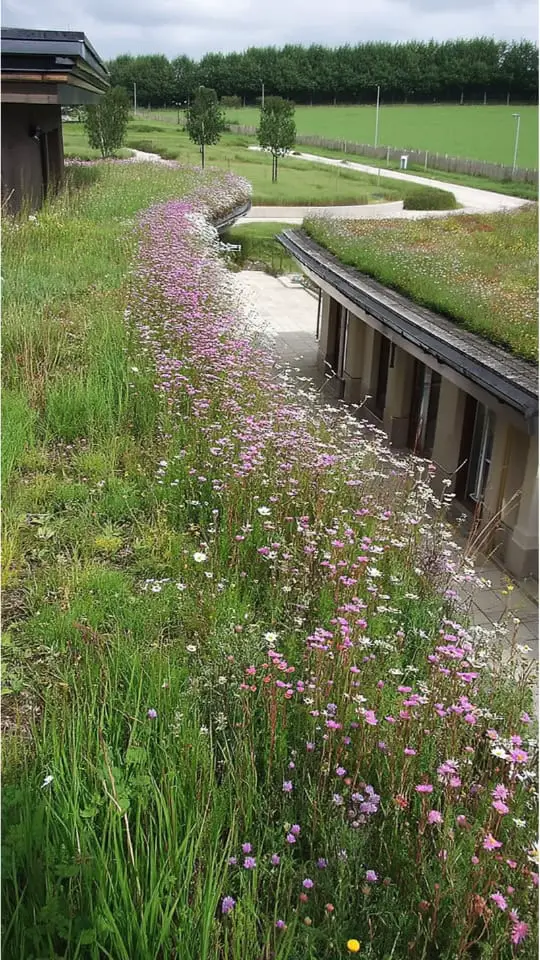
They also insulate buildings, saving energy during hot or cold months. The plants reduce rainwater runoff too by soaking up water before it hits the streets below.
I always choose hardy options like perennial wildflowers that can handle wind and drought on exposed roofs.
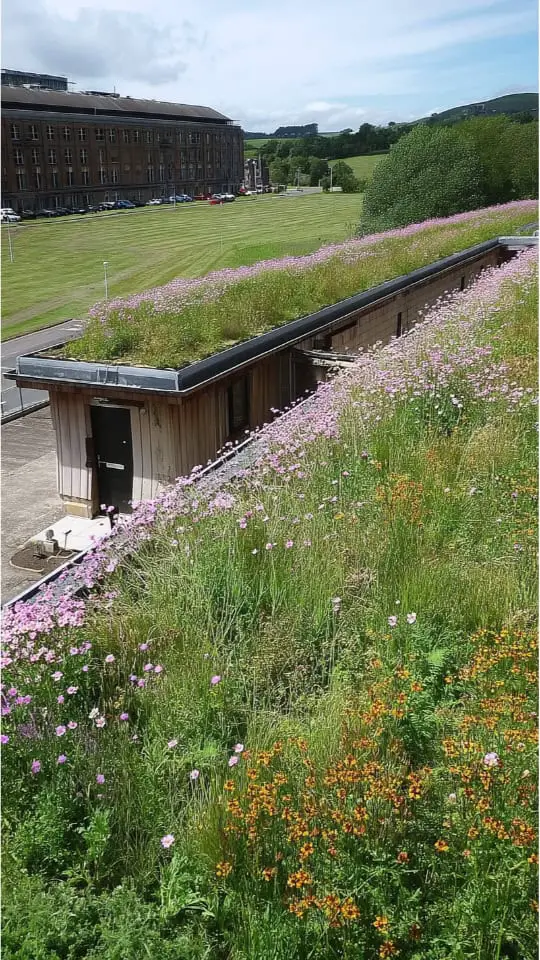
Annual overseeding keeps the garden colorful year after year!
Vertical
A vertical garden can transform any small space into a colorful paradise. I love using lightweight soil mix and modular panels for easy setup.
Bright wildflowers, like sweet william or perennial wildflowers, make the display pop with color. Trailing greenery softens the edges and adds depth to the design.

This type of garden works great in sunny spots but fits partial sun spaces too. It acts as both a living privacy screen and an art piece on walls or fences.
Regular watering is key since vertical gardens dry quickly. Native plants also help attract pollinators such as butterflies while keeping maintenance simple!

Filled Rock
I love how rocks can make a wildflower garden pop. They help with drainage and give the plants extra stability.
In my experience, planting vivid flowers like cosmos and cornflowers between them works best. These blooms bring bright colors all summer long, even in partial sun.
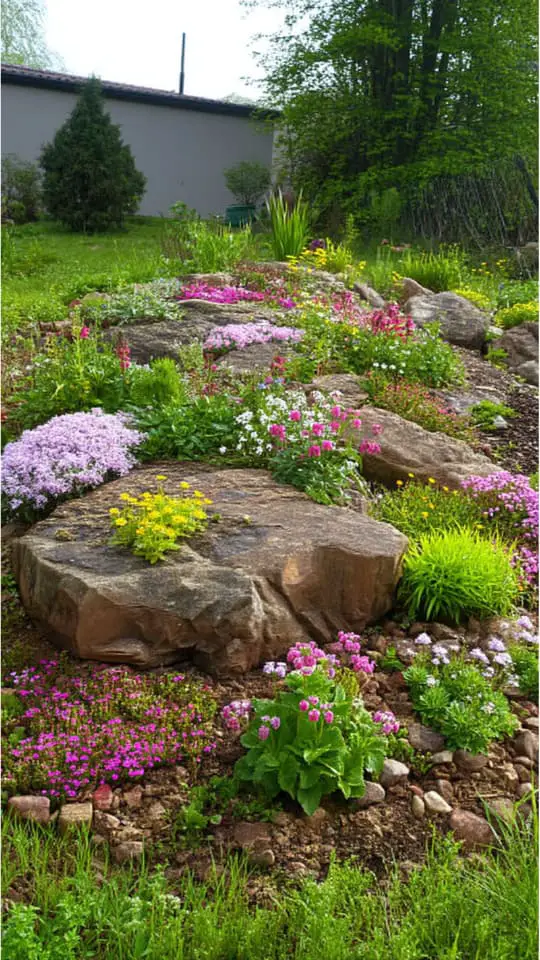
Rocks also create tiny microclimates for hardy perennials or annuals that need different conditions. Small pollinators seem to adore these spaces!
Layering plants alongside the stones mimics natural meadows or rocky slopes beautifully. Once set up, this type of garden barely needs upkeep—perfect for busy gardeners like me!
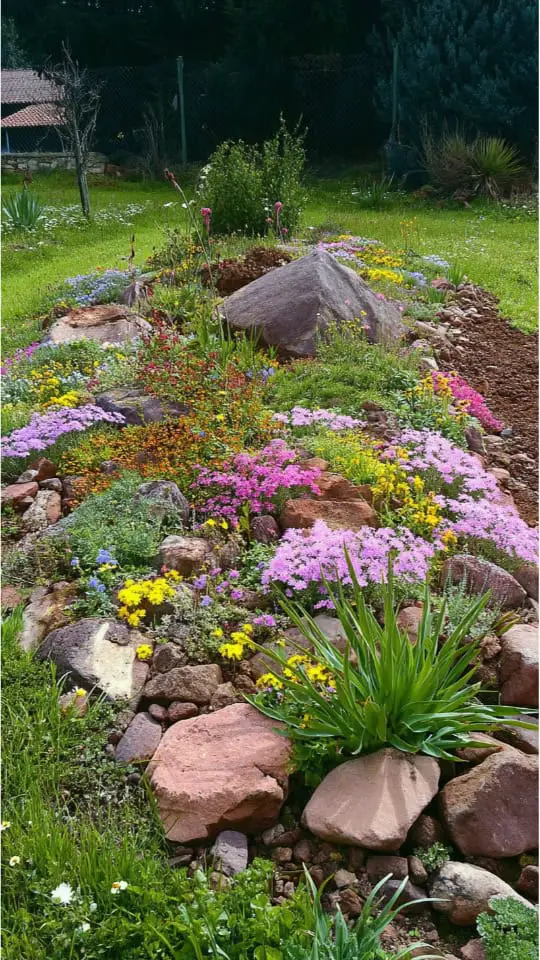
Conclusion
Wildflower gardens bring joy and color to any space. They invite butterflies, bees, and birds while adding charm.
With 25 ideas, you can shape your own unique garden spot. Start small or go big; either way, it feels magical watching blooms grow.
Try it out and see life burst in every corner!
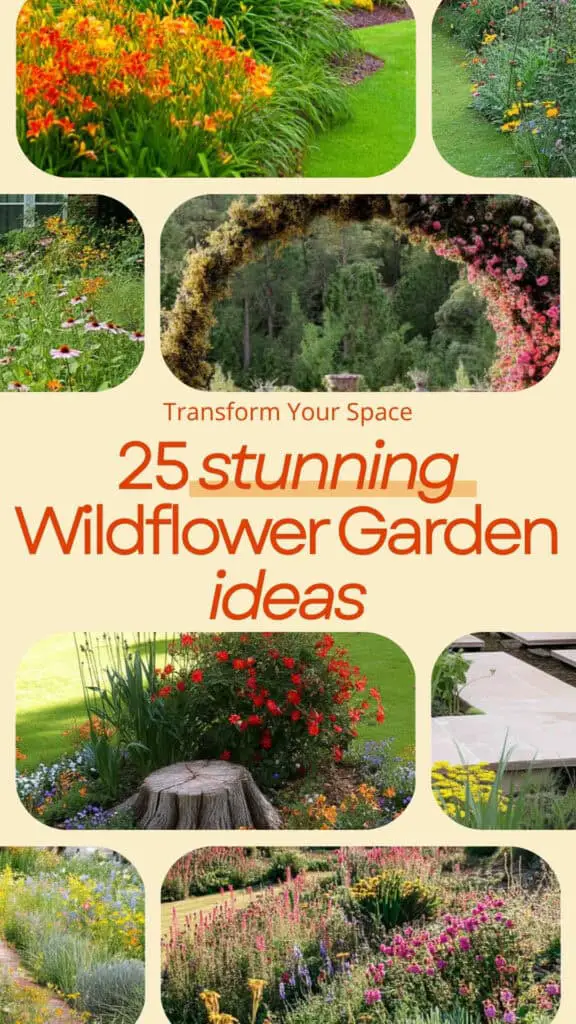
FAQs
1. What are some good plants for a wildflower garden?
Native plants like sweet william, digitalis purpurea, and agastache foeniculum work well. They thrive in local conditions and attract pollinators.
2. Should I plant annual or perennial wildflowers?
It depends on your goal. Annual wildflowers bloom quickly but only last one season. Perennial wildflowers return yearly and create a long-term garden.
3. How much sun does a wildflower garden need?
Wildflowers can grow in full sun, partial sun, or even full shade depending on the type of plants you choose.
4. How do I care for my wildflower garden?
Watering wildflowers is important during dry spells, especially after spring planting. Use hardy fescues or turf grasses to reduce weeds around them.
5. Can I turn my lawn into a butterfly garden with flowers?
Yes! Remove sod first, then plant native species that butterflies love like sweet william and other colorful blooms from your area.


